Cerebellar ataxia is loss of muscle coordination caused by disease or injury to the cerebellum. The cerebellum is the area of the brain responsible for coordinating voluntary muscles and maintaining balance.

More to Know
People of all ages can have cerebellar ataxia. In children 3 years old or younger, it's most often caused by viruses and has only short-term effects. For adults, cerebellar ataxia is usually the result of head trauma or an infection or disease of the cerebellum. Alcohol abuse, medications, and exposure to toxic chemicals can also cause cerebellar ataxia.
People with cerebellar ataxia may have trouble walking, speaking, sitting still, or keeping their hands steady. They may also have uncoordinated or repetitive eye movement. Symptoms can be sudden and brief (acute) or can occur slowly and be long-lasting (chronic). Cerebellar ataxia can come and go or get progressively worse over time.
Treatment of cerebellar ataxia is based on the underlying problem that caused it.
Keep in Mind
While some people will have permanent symptoms of cerebellar ataxia, many patients can be treated with medication or surgery with good outcomes. When caused by viral infections, cerebellar ataxia usually doesn't require treatment and most people will recover fully within a few months.
All A to Z dictionary entries are regularly reviewed by KidsHealth medical experts.


